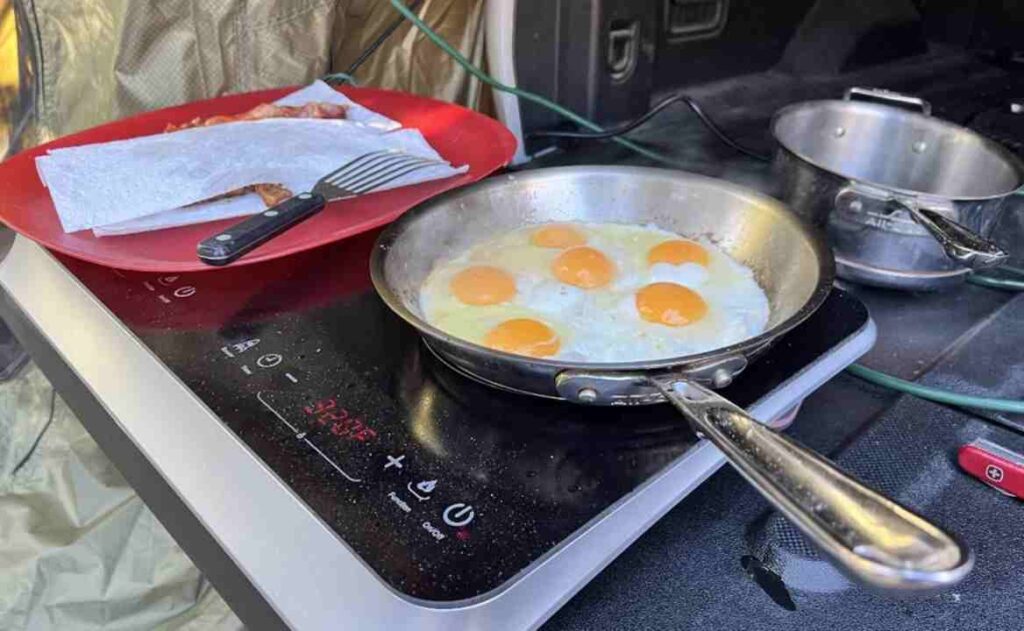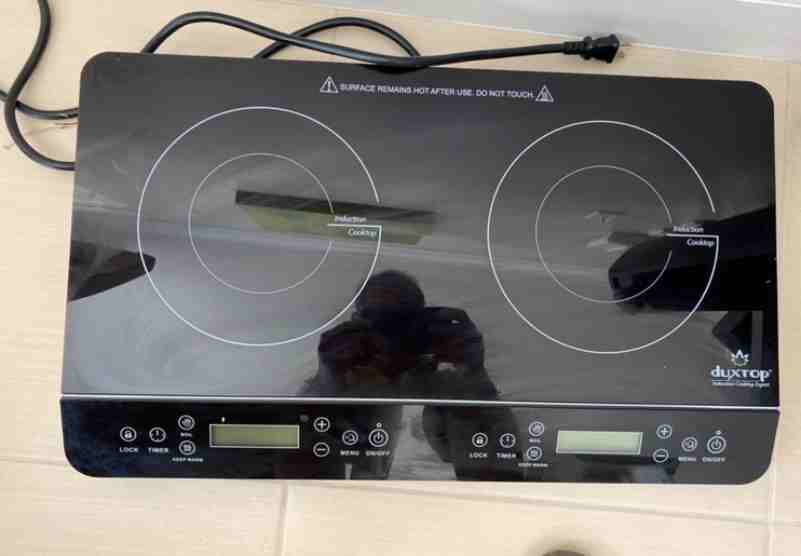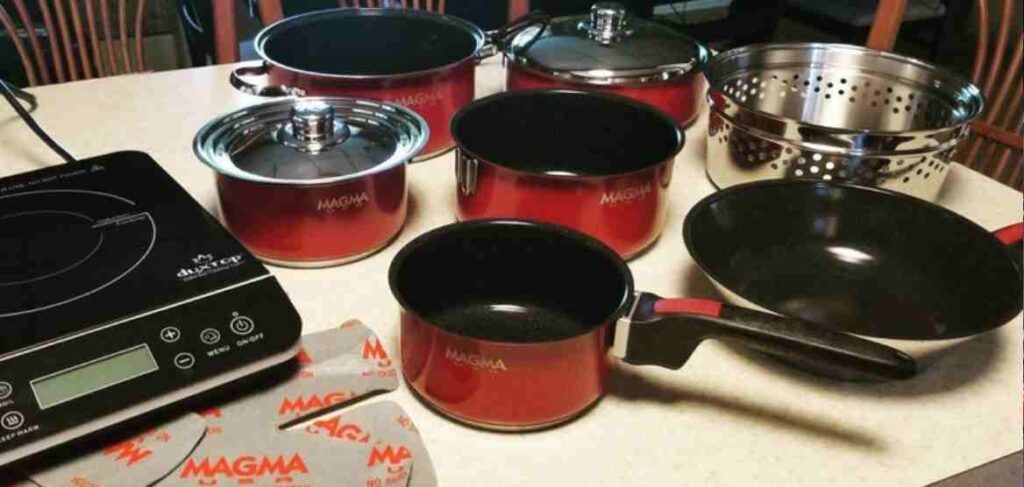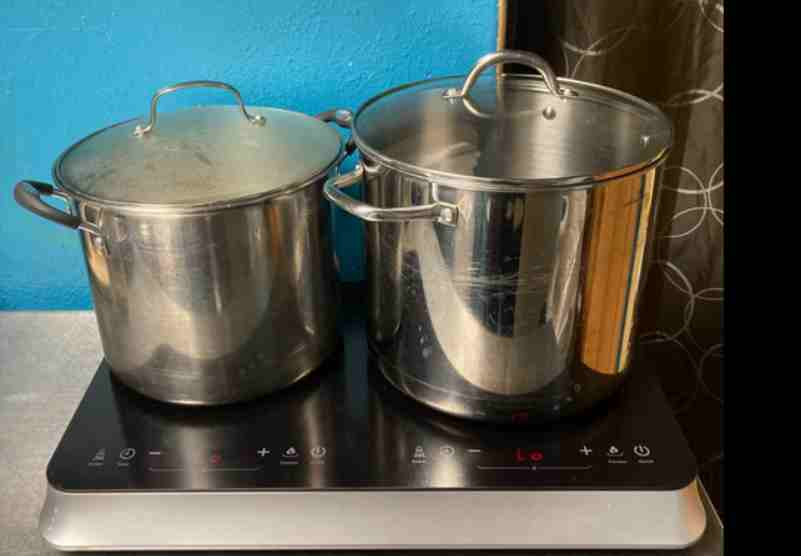RVs have come a long way in terms of appliances. And RV appliance trends often follow home appliance trends, which begs the question, “can you use an induction cooktop in an RV?”
An induction cooktop is the preferred cooktop for many RVers and is fast replacing gas cooktops in newer RVs due to their fast heating, energy efficiency, and safety features. On the flip side, you need to Consider cookware compatibility and a power source.
In this article, we’ll give you some background on Induction cooktops and discuss the advantages and challenges of using an induction cooktop in your RV.

How Induction Cooktops Work
Induction cooktops use magnetic induction to directly heat your cookware instead of heating the air around it as traditional electric or gas cooktops do. An electric current runs through a coil under the cooktop surface, creating a magnetic field.
When you place ferromagnetic cookware, like cast iron or stainless steel, on the cooktop, the magnetic field induces an electrical current in the cookware. This current creates heat and friction cooking your food.
The best part? The cooktop surface stays cool to the touch because all the heat is generated in the cookware, not in the air around it.
Cooking with induction is efficient and fast because the heat goes straight to the cookware, and the cooktop can respond quickly to temperature adjustments making it easier to cook all kinds of food with accuracy and consistency.
Advantages of Induction Cooktops
Induction cooktops in RVs offer advantages such as fast heating, energy efficiency, improved safety, ease of cleaning, compact size, and precision cooking.
Fast Heating
Induction cooktops heat up quickly and respond to temperature changes almost instantly, making them more efficient than other cooking methods.
Induction cooktops use magnetic induction to heat cookware directly, which makes them fast and energy efficient. The speed at which an induction cooktop heats depends on several factors, such as the size of the cookware, the type of food being cooked, and the temperature setting.
Typically, induction cooktops heat faster than traditional gas or electric cooktops because they transfer heat directly to the cookware. The heating process can be instant, with some induction cooktops capable of boiling a pot of water in under a minute. Additionally, induction cooktops are more responsive to temperature changes, making it easier to adjust and maintain the desired cooking temperature.
Energy Efficiency
As an RV owner, you may be interested in ways to save energy while cooking on the road. Induction cooktops are more energy-efficient than gas or electric cooktops as they heat only the cookware and not the surrounding air.
Since they work by using magnetic fields to heat the cooking pan directly, less energy is lost. This results in faster, more precise cooking. With their energy-saving capabilities and ease of use, induction cooktops are an excellent choice for RV enthusiasts looking to cook efficiently while on the road.
Improved Safety
As an RV owner, you want to ensure that your cooking experience is convenient and safe. Thanks to their improved safety features, induction cooktops have become a popular option for RV kitchens.
Induction cooktops do not produce an open flame, reducing fire risk. And they only heat up when a magnetic pot or pan is placed on the cooking surface. This means that you won’t get burned even if you accidentally touch the surface. Additionally, the cooktop will automatically turn off if a pot or pan is removed, preventing accidental fires.
Ease of Cleaning
Trying to keep a gas stovetop clean is the bane of my existence. With an induction cooktop, you’ll find that cleaning is a breeze. Unlike traditional gas or electric cooktops, induction surfaces don’t get as hot, so spills and splatters won’t bake on. Additionally, the smooth glass surface makes wiping up spills and messes a simple task.
Cleaning an induction cooktop is as easy as wiping it down with a damp cloth. You can use a mild detergent and a non-abrasive sponge if there are stubborn spills or stains.
Because the surface doesn’t get hot, you don’t have to worry about damaging it or waiting to cool down before cleaning. You can clean the surface while you’re cooking. This saves time and ensures that your cooking area stays hygienic.
Compact Size
As an RV owner, you know how important it is to make the most of your limited space. One of the most significant advantages of induction cooktops is their compact size. Unlike traditional gas or electric cooktops, induction cooktops don’t require a bulky heating element. This means that they can be designed to be more compact and take up less counter space in your RV kitchen.
The compact design of induction cooktops makes them ideal for RV kitchens. You’ll be able to free up valuable counter space, giving you more room to prepare and store food. Additionally, you’ll be able to cook on multiple burners at once, allowing you to prepare meals more efficiently. The compact design also makes it easy to store the cooktop when not in use, giving you more room to relax and enjoy your travels.

Precision Cooking
Induction cooktops offer a level of precision that’s unmatched by traditional gas or electric cooktops. The induction technology heats the cookware directly, rather than the surrounding air, allowing for more precise temperature control.
With an induction cooktop in your RV, you’ll be able to cook confidently. The precise temperature control makes it easy to boil water, simmer sauces, and fry food to perfection.
You’ll also appreciate the quick response time when adjusting the heat. The induction technology heats and cools the cookware rapidly, allowing you to make precise adjustments on the fly.
Disadvantages of Induction Cooktops
Using an induction cooktop in an RV can be challenging for several reasons. Next, we’ll discuss some of the challenges of using induction cooktops in an RV.
Cookware Compatibility

Induction cooktops require cookware made of ferromagnetic (a fancy word for iron) materials like cast iron or stainless steel.
So, as an RV owner, you may find that cookware compatibility is one of the biggest challenges of using an induction cooktop in your RV. Induction cooktops use magnetic fields to heat the cookware, meaning that the cookware must be magnetic to work correctly. This means that traditional non-magnetic cookware such as aluminum, glass, or copper will not work with an induction cooktop.
This means that if you are using an induction cooktop in your RV, you may need to purchase new cookware compatible with induction cooking. This can include magnetic stainless steel or cast iron cookware. However, finding these materials in small, compact sizes suitable for RV kitchens can be difficult and expensive.
We bought the Magma Non-stick cookware set. It’s pricey, but it cleans up easily. They all have a thick bottom for even heating. Plus, the handles are insulated, so they aren’t hot when you pick them up. Plus, because they are a nested set, they are easy to store and don’t take up much room.
Cost
You may be considering using an induction cooktop as a convenient and efficient way to cook while on the road. However, one of the main challenges associated with induction cooktops is the cost. Both induction cooktops and compatible cookware can be more expensive compared to traditional gas or electric cooktops and non-magnetic cookware.
Induction cooktops can range in price from several hundred to several thousand dollars for a built-in unit. This is a big layout of cash for the average RV owner.
In addition to the cost of the cooktop, you will probably need to purchase new cookware compatible with induction cooking. Magnetic stainless steel or cast iron cookware can be more expensive than traditional non-magnetic cookware, adding additional cost to the equation.
Another challenge associated with the cost of induction cooktops and cookware is the limited availability of compact and lightweight options for RV kitchens. Similarly, finding compact magnetic cookware in small sizes can also be more challenging.
Learning Curve
Some people may find induction cooktops more challenging to use and control than traditional ones. Getting used to precise temperature control and quick response time may take some time.
One aspect of the learning curve for induction cooktops is getting used to the required cookware types.
Another aspect of the learning curve is understanding how induction cooktops work. Induction cooktops heat the cookware directly rather than heating the air around the cookware.
This can result in faster cooking times and improved energy efficiency, but it also means adjusting your cooking techniques. For example, you may need to use lower heat settings or stir your food more frequently to prevent burning.
In addition to the challenges associated with cookware and cooking techniques, you may also need to adjust to the controls and interface of your induction cooktop. Some induction cooktops have advanced features, such as programmable cooking modes, that can take some time to master.
Power Requirements

Induction cooktops require a significant amount of power, typically ranging from 1500 to 1800 watts. T means that you must have a reliable and stable power source to use the cooktop.
Many RVs are equipped with generators or inverters to provide power on the road, but it is important to make sure that your power source can support the power needs of the induction cooktop.
In addition to the power requirements of the induction cooktop, you also need to consider the power needs of the cookware.
Magnetic cookware, such as stainless steel or cast iron, can also be more power-hungry compared to traditional non-magnetic cookware. This means that you may need to adjust your cooking habits, such as using lower heat settings, in order to conserve power.
Finally, it is important to consider the safety implications of using an induction cooktop in an RV. Overloading your power system, either through the cooktop or other appliances, can result in a power failure or even a fire. It is important to make sure that your RV is equipped with the necessary power protection devices, such as surge protectors or circuit breakers, to prevent these types of incidents.
Limited Availability
Induction cooktops are not as widely available as traditional gas or electric cooktops, so you may have a harder time finding one that fits your needs and your RV.
In some cases, you may need to order the induction cooktop and cookware online, which can add to the cost and planning time for your trip. Shipping and handling costs for bulky items such as induction cooktops and heavy cookware can also be significant, making it more challenging to purchase these items for your RV.
Furthermore, finding replacement parts or repairing the induction cooktop while on the road can be difficult, especially in remote locations. Is important to plan ahead and consider the availability of repair services or replacement parts in the areas where you plan to travel.
If you’d like to know about some other RV appliances, read the article that I wrote.
Conclusion
Induction cooking in RVs offers many advantages over traditional cooking methods, including improved efficiency, safety, and convenience. However, there are also some challenges that need to be considered, such as compatibility with existing cookware, higher upfront costs, and limited availability of repair services in remote locations. Despite these challenges, many RV enthusiasts are choosing to switch to induction cooking for its numerous benefits, making it an increasingly popular choice for those looking to upgrade their on-the-road culinary experience.
